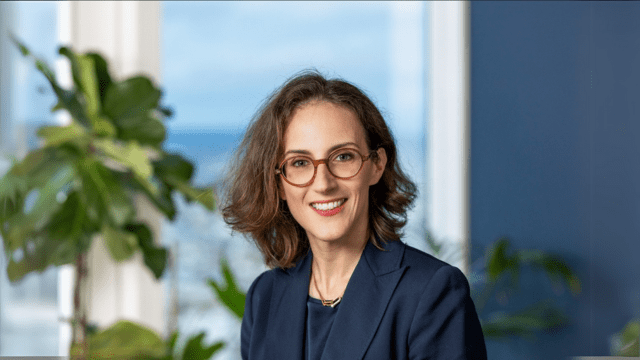Éléonore Arfan (Mechanical Engineering, 2002) is a patent engineer—a profession she embodies with both rigour and passion, combining curiosity with a deep scientific culture. In search of her professional fulfilment, she has built a tailor-made career path, cultivating her intellectual curiosity across three different fields. Her trajectory led her to Santarelli, one of the largest intellectual property law firms, where she has been a partner since 2021.
Éléonore Arfan’s solid academic background began to take shape as soon as she obtained her science baccalauréat in 2000. “While some of my classmates already had clear ambitions for top schools or specific careers, I personally had no idea what I wanted to do with my life,” she confides. She ended up, almost by default, in a dual degree in economics/management and Spanish LLCE (Language, Literature and Foreign Civilization) at the University of Nanterre. It was a demanding course she enjoyed, but her interest in physics resurfaced. “I realized I didn’t want to wake up at 40 and realize I hadn’t even tried.” She took the leap, switching at the end of the first trimester to a Bachelor's degree in Matter Sciences at Paris VI – Pierre and Marie Curie University. Goodbye Nanterre, hello Jussieu. Despite the complex administrative process, Éléonore worked relentlessly over the summer to catch up and directly enter the second year. “The workload was intense, especially having to learn the entire first semester’s material on my own,” she recalls.
At Jussieu, a professor noticed her and guided her toward the Mechanical Engineering Magistère at ENS Paris-Saclay. “The first year was really tough,” she remembers. “I joined students who had mostly come from preparatory classes. They had already studied subjects I didn’t even know, not to mention the very high level in mechanics.” Driven by a deep ambition to complete her academic journey, she earned a Master’s degree in numerical methods, then pursued a PhD in materials mechanics at the LMT (now LMPS) in Cachan, under the supervision of François Hild and Nicolas Schmitt. She defended her thesis in 2009.
Although Éléonore chose not to take the agrégation exam, as she wasn’t drawn to teaching in secondary schools, she “loved” teaching as a TD (tutorial) instructor at the university. “But the ideal image I initially had of a researcher-teacher—something between Gyro Gearloose and Professor Calculus—quickly collided with a less glamorous reality.” The PhD student began to look elsewhere and decided, in parallel with her thesis, to enrol in an evening Master’s in economics and management at the IAE of Paris, from 2006 to 2008.
The most literary of scientific professions
After defending her thesis and obtaining her second Master’s, Éléonore finally allowed herself to look for a job. She came across a listing posted by APEC for a position as a patent engineer. Three weeks later, she had started her first job at Novagraaf, a major intellectual property consulting firm. Mentored by two passionate senior colleagues, Éléonore learned the ropes of the patent engineering profession, which she describes as “the most literary of scientific careers.” “It’s a niche job, with very few professionals in France. It’s both technical and cross-disciplinary, also close to research: we research and write a lot.” Once again, she felt the need to strengthen her academic background—this time in law, which is essential to the profession. Some patent professionals even go as far as qualifying as lawyers. She completed a Master’s degree in intellectual property law, in addition to the mandatory certifications for her profession.
Midwives of ideas
Éléonore left Novagraaf in 2012 to join Santarelli, a firm born from one of the oldest intellectual property firms in France, dating back to the second half of the 19th century. In 2021, she became a partner. “We improve with time, gaining the maturity that once impressed us,” she reflects, visibly moved. Now it’s her turn to manage a small team. “Being a partner means taking on more or less responsibility depending on your interest or the firm’s size,” she explains. She was quickly entrusted with cross-functional roles, working alongside her supervisor in managing internal and external projects.
Over time, the engineer’s “portfolio” of patents has expanded, immersing her in a wide range of scientific techniques and cultures. “We’re constantly working with all kinds of inventors—academic researchers, industry professionals, or individuals. All of them are extremely specialised in their fields, so we listen carefully. Sometimes, we even act as ‘midwives of ideas.’”
The ENS Paris-Saclay toolkit
Éléonore Arfan’s journey reflects an impressive work ethic, matched by iron willpower. In this, she readily admits to often drawing on what she gained from ENS Paris-Saclay. “The School gave me a tremendous scientific culture that allows me to approach a wide range of fields. Science shapes the mind, structures the thinking, and whatever you do afterwards, it proves useful.” “But most importantly, the School teaches a mindset—how to ‘learn to learn’,” Éléonore concludes, recalling a saying by Pierre-Alain Boucard, one of her professors at the ENS: ‘you only learn what you already know’. She strongly encourages students not to hesitate to give themselves the means to follow their aspirations.

Comments0
Please log in to see or add a comment
Suggested Articles

